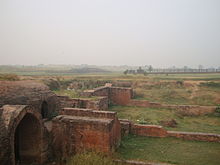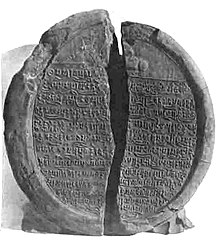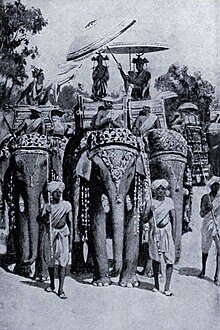Harsha
| Harsha | |
|---|---|
| Maharajadhiraja | |
 Coin of Harshavardhana, c. 606–647 CE.[1] | |
| Maharajadhiraja of Kannauj | |
| Reign | April 606 – 647 |
| Predecessor | Rajyavardhana (as King of Thanesar) |
| Successor | Arunāsva (as King of Kannauj) |
| Born | 4 June 590[2] possibly Sthanvishvara, Kingdom of Thanesar (present-day Thanesar, Haryana, India)[3][4] |
| Died | 647 (aged 56-57) possibly Kanyakubja, Empire of Kannauj (present-day Kannauj, Uttar Pradesh, India)[5] |
| Dynasty | Pushyabhuti |
| Father | Prabhakarvardhana |
| Mother | Yasomati |
| Religion | Shaivism Buddhism (according to Xuanzang) |
| Signature | |

Harshavardhana (Sanskrit: हर्षवर्धन; 4 June 590 – 647) was emperor of Kannauj from April 606 until his death in 647. He was the king of Thanesar who had defeated the Alchon Huns,[7] and the younger brother of Rajyavardhana, son of Prabhakaravardhana and last king of Thanesar. He was one of the greatest kings of the Kingdom of Kannauj, which under him expanded into a vast realm in northern India.
At the height of Harsha's power, his realm covered much of northern and northwestern India, with the Narmada River as its southern boundary. He eventually made Kanyakubja (present-day Kannauj, Uttar Pradesh state) his imperial capital, and reigned till 647 CE.[8] Harsha was defeated by the Emperor Pulakeshin II of the Chalukya dynasty in the Battle of Narmada, when he tried to expand his empire into the southern peninsula of India.[9]
The peace and prosperity that prevailed made his court a centre of cosmopolitanism, attracting scholars, artists and religious visitors from far and wide.[8] The Chinese traveller Xuanzang visited the imperial court of Harsha and wrote a very favourable account of him (as Shiladitya), praising his justice and generosity.[8] His biography Harshacharita ("The Life of Harsha") written by the Sanskrit poet Banabhatta, describes his association with Sthanesvara, besides mentioning a defensive wall, a moat and the palace with a two-storied Dhavalagriha (white mansion).[10]
Early years

Much of the information about Harsha's youth comes from the account of Bāṇabhaṭṭa.[5] Harsha was the second son of Prabhakarvardhana, king of Thanesar. According to some authorities, he belonged to the Bais clan of Rajputs and a ruler of the Pushyabhuti dynasty.[11][5] After the downfall of the Gupta Empire in the middle of the 6th century, Northern India was split into several independent kingdoms. The northern and western regions of the Indian Subcontinent passed into the hands of a dozen or more feudatory states. Prabhakaravardhana, the monarch of Sthanvesvara, who belonged to the Vardhana family, extended his control over neighbouring states. Prabhakaravardhana was the first monarch of the Vardhana dynasty with his capital at Sthanvesvara. After Prabhakaravardhana's died in 605, his eldest son, Rajyavardhana, ascended the throne. Harshavardhana was Rajyavardhana's younger brother. This period of kings from the same line has been referred to as the Vardhana dynasty in many publications.[12][dead link][13][14][15][page needed]
At the time of Hiuen Tsang's visit, Kanyakubja was the imperial capital of Harshavardhana, the most powerful sovereign in Northern India.
K.P. Jaiswal in Imperial History of India, says that according to a 7-8th century Buddhist text, Mañjuśrī-mūla-kalpa, Harsha was born of King Vishnu (Vardhana) and his family was of Vaishya varna.[16][page needed] This is supported by some more writers.[17][18][19][20]
Ascension

Harsha's sister Rajyashri had been married to the Maukhari monarch, Grahavarman. This king, some years later, had been defeated and killed by King Devagupta of Malwa and after his death Rajyashri had been captured and imprisoned by the victor. Harsha's brother, Rajyavardhana, then the king at Sthanesvara, could not accept this affront to his sister and his family. So he marched against Devagupta and defeated him. However, Shashanka, the King of Gauda in Eastern Bengal, then entered Magadha as a friend of Rajyavardhana, but was in a secret alliance with the Malwa king.[citation needed] Accordingly, Shashanka treacherously murdered Rajyavardhana.[22] In the meantime, Rajyashri escaped into the forests. On hearing about the murder of his brother, Harsha resolved at once to march against the treacherous King of Gauda, but this campaign remained inconclusive and beyond a point he turned back. Harsha ascended the throne at the age of 16. His first responsibility was to rescue his sister and to avenge the killings of his brother and brother-in-law. He rescued his sister when she was about to immolate herself.
Reign
As Northern India reverted to small republics and small monarchical states ruled by Gupta rulers after the fall of the prior Gupta Empire, Harsha united the small republics from Punjab to central India, and their representatives crowned him emperor at an assembly in April 606 giving him the title of Maharajadhiraja. Harsha established an empire that brought all of northern India under his rule.[8] The peace and prosperity that prevailed made his court a centre of cosmopolitanism, attracting scholars, artists and religious visitors from far and wide. The Chinese traveller Xuanzang visited the imperial court of Harsha, and wrote a favourable account of him, praising his justice and generosity.[8]
Pulakeshin II repelled an invasion led by Harsha on the banks of Narmada in the winter of 618–619. Pulakeshin then entered into a treaty with Harsha, with the Narmada River designated as the border between the Chalukya Empire and that of Harshavardhana.[23][24]
Xuanzang describes the event thus:
- "Shiladityaraja (i.e., Harsha), filled with confidence, marched at the head of his troops to contend with this prince (i.e., Pulakeshin); but he was unable to prevail upon or subjugate him".
In 648, Tang Chinese emperor Tang Taizong sent Wang Xuance to India in response to emperor Harsha having sent an ambassador to China. However once in India, he discovered that Harsha had died and the new king Aluonashun (supposedly Arunāsva) attacked Wang and his 30 mounted subordinates.[25] This led to Wang Xuance escaping to Tibet and then mounting a joint expedition of over 7,000 Nepalese mounted infantry and 1,200 Tibetan infantry and attacking Indian state on June 16. The success of this attack won Xuance the prestigious title of the "Grand Master for the Closing Court."[26] He also secured a reported Buddhist relic for China.[27][full citation needed] 2,000 prisoners were taken from Magadha by the Nepali and Tibetan forces under Wang.[28] Tibetan and Chinese writings document describe Wang Xuance's raid on India with Tibetan soldiers.[29] Nepal had been subdued by the Tibetan King Songtsen.[30] The Indian pretender was among the captives.[31][32] The war happened in 649.[citation needed] Taizong's grave had a statue of the Indian pretender.[33] The pretender's name was recorded in Chinese records as "Na-fu-ti O-lo-na-shuen" (Dinafudi is probably a reference to Tirabhukti).[34][35][36]
Xuanzang mentions that Harsha waged wars to bring "the Five Indias under allegiance" in six years.[37] Xuanzang uses the term "Five Indias" (or "Five Indies" in some translations) inconsistently, variously applying it to refer to Harsha's territories in northern India or to the entire subcontinent, grouped around Central India in the four directions.[38][39] Based on this statement, historians such as R.K. Mookerji and C.V. Vaidya have dated Harsha conquests to 606-612 CE. However, it is now known that Harsha engaged in wars and conquests for several more years.[37] Moreover, whether Xuanzang used the term "Five Indias" to describe Harsha's territory in a narrower or wider sense, his statement is hyperbole it cannot be used to make conclusions about Harsha's actual territory. While Harsha was the most powerful emperor of northern India, he did not rule the entire northern India.[40]
Religion and Religious Policy

Like many other ancient Indian rulers, Harsha was eclectic in his religious views and practices. His seals describe his ancestors as worshippers of the Hindu sun god, Surya, his elder brother as a Buddhist, and himself as a Shaivite Hindu. His land grant inscriptions describe him as Parama-maheshvara (supreme devotee of Shiva). His court poet Bana also describes him as a Shaivite Hindu.[41]
Harsha's play Nāgānanda tells the story of the Bodhisattva Jīmūtavāhavana, and the invocatory verse at the beginning is dedicated to the Buddha, described in the act of vanquishing Māra (so much so that the two verses, together with a third, are also preserved separately in Tibetan translation as the *Mārajit-stotra).[42] Shiva's consort Gauri plays an important role in the play,[43] and raises the hero to life using her divine power.[44]
According to the Chinese Buddhist traveler Xuanzang, Harsha was a devout Buddhist. Xuanzang states that Harsha banned animal slaughter for food, and built monasteries at the places visited by Gautama Buddha. He erected several thousand 100-feet high stupas on the banks of the Ganges river, and built well-maintained hospices for travellers and poor people on highways across India. He organized an annual assembly of global scholars, and bestowed charitable alms on them. Every five years, he held a great assembly called Moksha. Xuanzang also describes a 21-day religious festival organized by Harsha in Kanyakubja; during this festival, Harsha and his subordinate kings performed daily rituals before a life-sized golden statue of the Buddha.[41]
Since Harsha's records describe him as a Shaivite Hindu, his conversion to Buddhism would have happened, if at all, in the later part of his life. Even Xuanzang states that Harsha patronised scholars of all religions, not just Buddhist monks.[41] According to historians such as S. R. Goyal and S. V. Sohoni, Harsha was personally a Shaivite Hindu and his patronage of Buddhists misled Xuanzang to portray him as a Buddhist.[45]
Literary prowess
Harsha is widely believed to be the author of three Sanskrit plays Ratnavali, Nagananda and Priyadarsika.[46] While some believe (e.g., Mammata in Kavyaprakasha) that it was Dhāvaka, one of Harsha's court poets, who wrote the plays as a paid commission, Wendy Doniger is "persuaded, however, that king Harsha really wrote the plays ... himself."[46]
In popular culture
A 1926 Indian silent film, Samrat Shiladitya, about the emperor was directed by Mohan Dayaram Bhavnani.[47]
See also
References
- ^ Research Coins: Electronic Auction Archived 2 May 2019 at the Wayback Machine cngcoins.com. Retrieved 27 July 2021
- ^ "Harsha And Latter Kings : Vaidya, C.v. : Free Download, Borrow, and Streaming : Internet Archive". Internet Archive. 3 July 2015. Retrieved 24 July 2024.
- ^ Bradnock, Robert; Bradnock, Roma (1999). India Handbook 2000. McGraw-Hill/Contemporary. p. 454. ISBN 978-0-8442-4841-7.
Thanesar near Kurukshetra , is the birthplace of the ruler Harsha Vardhana ( 590-647)...
- ^ Magill, Frank Northen; Aves, Alison (1998). Dictionary of World Biography: The Middle Ages. Routledge. p. 430. ISBN 978-1-57958-041-4.
Born: c. 590; probably Thanesar, India
- ^ a b c Magill, Frank Northen; Aves, Alison (1998). Dictionary of World Biography: The Middle Ages. Routledge. p. 430. ISBN 978-1-57958-041-4.
- ^ Schwartzberg, Joseph E. (1978). A Historical atlas of South Asia. Chicago: University of Chicago Press. p. 146, map XIV.2 (d). ISBN 0226742210. Archived from the original on 24 February 2021. Retrieved 25 March 2021.
- ^ India: History, Religion, Vision and Contribution to the World, by Alexander P. Varghese p.26
- ^ a b c d e International Dictionary of Historic Places: Asia and Oceania by Trudy Ring, Robert M. Salkin, Sharon La Boda p.507
- ^ Ancient India by Ramesh Chandra Majumdar p.274
- ^ Vasudeva Sharana Agrawala (1969). The deeds of Harsha: being a cultural study of Bāṇa's Harshacharita. Prithivi Prakashan. p. 118.
- ^
- Beal, Samuel (5 November 2013). The Life of Hiuen-Tsiang. Routledge. p. 83. ISBN 978-1-136-37629-0.
The king is a Bais Rajput. His name is Harsha- vardhana; his father's name was Prakaravardhana;" his senior brother was called Rajyavardhana. Harsha- vardhana, the present king, is virtuous and patriotic; all people celebrate his praises in songs.
- K̲h̲ān̲, Rānā Muḥammad Sarvar (2005). The Rajputs: History, Clans, Culture, and Nobility. Rana Muhammad Sarwar Khan. p. 105.
BAIS A sept of Rajputs found in Uttar Pradesh , Gautam Raja is said to be their founder. Harsha Vardhana who was ruler of Mathura and Kannauj ( Uttar Pradesh ) in 7th century was a Bais Rajput.
- Devahuti, D. (1983). Harsha: A Political Study. Oxford University Press. p. 72. ISBN 978-0-19-561392-6.
The Chinese text simply states that Harsha was of fei-she (vaisya) extraction. The explanation given in the notes (Beal i, p. 209 n. 12, 'Life', p. 83 n. 1, cf. Watters i, pp. 344-5) that he was a Bais Rajput stems from Cunningham.
- Goyala, Śrīrāma (1986). Harsha and Buddhism. Kusumanjali Prakashan. p. 16.
- Rajasthan Directory & Who's who. Hindi Sahitya Mandir. 1982. p. 5.
Thereafter, in the begin ning of the 7th century, Harsha Vardhan, who was a Kshatriya of the Bais clan, ceded a large part of this province into his territory.
- Beal, Samuel (5 November 2013). The Life of Hiuen-Tsiang. Routledge. p. 83. ISBN 978-1-136-37629-0.
- ^ Harsha Charitra by Banabhatt
- ^ Legislative Elite in India: A Study in Political Socialization by Prabhu Datta Sharma, Publ. Legislators 1984, p32
- ^ Revival of Buddhism in Modern India by Deodas Liluji Ramteke, Publ Deep & Deep, 1983, p19
- ^ Some Aspects of Ancient Indian History and Culture by Upendra Thakur, Publ. Abhinav Publications, 1974,
- ^ K. P. Jayaswal (1934). An Imperial History Of India.
- ^ Sen, Sailendra Nath (1999), Ancient Indian History and Civilization, New Age International, p. 546, ISBN 9788122411980, archived from the original on 17 April 2023, retrieved 19 March 2023
- ^ Chattopadhyay, Amal (1994), Bhupendranath Datta and His Study of Indian Society, K.P. Bagchi & Company, p. 103, ISBN 9788170741473, archived from the original on 17 April 2023, retrieved 19 March 2023
- ^ Arya, Raj Narain (2001), Brahmin and Brahminism A Historical Survey, Blumoon Books, p. 82, ISBN 9788187190523, archived from the original on 7 April 2023, retrieved 19 March 2023
- ^ V, Ramanathan (2004), Hindu Civilisation and the Twenty-first Century, Bharatiya Vidya Bhavan, p. 350, ISBN 9788172763329, archived from the original on 6 April 2023, retrieved 19 March 2023
- ^ Sastri, Hirananda (1931). Epigraphia Indica Vol.21. pp. 74–80.
- ^ Bindeshwari Prasad Sinha (1977). Dynastic History of Magadha, Cir. 450-1200 A.D. Abhinav. p. 151.
- ^ "Pulakeshin's victory over Harsha was in 618 AD". The Hindu. 25 April 2016. p. 9.
- ^ "Study unravels nuances of classical Indian history". The Times of India". Pune. 23 April 2016. p. 3. Archived from the original on 2 November 2016. Retrieved 3 May 2016.
- ^ Bennett, Matthew (1998). The Hutchinson Dictionary of Ancient & Medieval Warfare. Chicago: Fitzroy Dearborn Publishers. p. 336. ISBN 978-1-57958-116-9.
- ^ Sen, Tansen (January 2003). Buddhism, Diplomacy, and Trade: The Realignment of Sino-Indian Relations ... By Tansen Sen, pg 23. University of Hawaii Press. ISBN 978-0-8248-2593-5. Archived from the original on 17 April 2023. Retrieved 15 March 2023.
- ^ "The Journal of the International Association of Buddhist Studies By International Association of Buddhist Studies". 4 April 2024. Archived from the original on 17 April 2023. Retrieved 18 March 2022.
- ^ Charles D. Benn (2002). Daily Life in Traditional China: The Tang Dynasty. Greenwood Publishing Group. pp. 38–. ISBN 978-0-313-30955-7.
- ^ Tansen Sen (January 2003). Buddhism, Diplomacy, and Trade: The Realignment of Sino-Indian Relations, 600-1400. University of Hawaii Press. pp. 253–. ISBN 978-0-8248-2593-5.
- ^ Tansen Sen (January 2003). Buddhism, Diplomacy, and Trade: The Realignment of Sino-Indian Relations, 600-1400. University of Hawaii Press. pp. 22–. ISBN 978-0-8248-2593-5.
- ^ Henry Yule (1915). Cathay and the Way Thither, Being a Collection of Medieval Notices of China. Asian Educational Services. pp. 69–. ISBN 978-81-206-1966-1.
- ^ Odorico (da Pordenone); Rashīd al-Dīn Ṭabīb; Francesco Balducci Pegolotti; Joannes de Marignolis; Ibn Batuta (1998). Cathay and the Way Thither: Preliminary essay on the intercourse between China and the western nations previous to the discovery of the Cape route. Munshiram Manoharlal Publishers Pvt. Ltd. p. 69. ISBN 9788121508391.
- ^ Prabodh Chandra Bagchi (2011). India and China : interactions through Buddhism and diplomacy ; a collection of essays. Anthem Press. pp. 158–. ISBN 978-93-80601-17-5.
- ^ See
- ^ D.C. Sircar (1990). Studies in the Geography of Ancient and Medieval India. Motilal Banarsidass. pp. 326–. ISBN 978-81-208-0690-0.
- ^ Sam Van Schaik (2011). Tibet: A History. Yale University Press. pp. 48–. ISBN 978-0-300-17217-1.
- ^ a b Bireshwar Nath Srivastava (1952). "The Chronology of the Campaigns of Harsha". Proceedings of the Indian History Congress. 15. Indian History Congress: 98–101. JSTOR 45436464.
- ^ Sally Wriggins (2020). Xuanzang: A Buddhist Pilgrim On The Silk Road. Routledge. p. 241. ISBN 9781000011098.
- ^ O. W. Wolters (2018). Craig J. Reynolds (ed.). Early Southeast Asia: Selected Essays. Cornell University Press. p. 123. ISBN 9781501731150.
- ^ Shankar Goyal (1992). History and Historiography of the Age of Harsha. Kusumanjali. pp. 217–218.
- ^ a b c Abraham Eraly (2011). The First Spring: The Golden Age of India. Penguin Books India. p. 86. ISBN 978-0-670-08478-4.
- ^ Michael Hahn (1996). ""The *Mārajitstotra by Harṣadeva, a third version of the Nāndī of the Nāgānanda?", Festschrift Dieter Schlingloff". Reinbek. pp. 109–126.
- ^ S. R. Goyal (2003). Indian Buddhism After the Buddha. Kusumanjali. p. 294. OCLC 907017497. Archived from the original on 7 April 2023. Retrieved 21 March 2023.
- ^ B.H. Wortham, ed. (2003). The Buddhist Legend of Jimutavahana. Asian Educational Services. p. xi. ISBN 9788120617339. Archived from the original on 7 April 2023. Retrieved 21 March 2023.
- ^ S. V. Sohoni (1989). "Review: Harsha and Buddhism". Annals of the Bhandarkar Oriental Research Institute. 70 (1/4). Bhandarkar Oriental Research Institute: 333–336. JSTOR 41693493.
- ^ a b Harsha (2006). "The Lady of the Jewel Necklace" and "The Lady who Shows Her Love". Translated by Wendy Doniger. New York University Press. p. 18.
- ^ Ashish Rajadhyaksha; Paul Willemen (10 July 2014). Encyclopedia of Indian Cinema. Taylor & Francis. p. 43. ISBN 978-1-135-94325-7.
Further reading
- Reddy, Krishna (2011), Indian History, Tata McGraw-Hill Education Private Limited, New Delhi
- Price, Pamela (2007), Early Medieval India, HIS2172 - Periodic Evaluation, University of Oslo
- "Conquests of Siladitya in the south" Archived 27 October 2014 at the Wayback Machine by S. Srikanta Sastri
